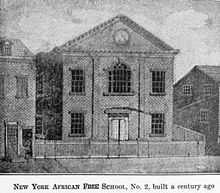Patrick H. Reason

Patrick Henry Reason, first named Patrice Rison (March 17, 1816 – August 12, 1898), was one of the earliest
Early life and education

Reason was born in 1816 in New York City as one of four children. His father, Michel Rison, was native to St. Anne Island, Guadeloupe, and his mother, Elizabeth Melville, was native to Saint-Domingue, the former French colony that achieved independence as Haiti. He was baptized Patrice Rison in April 1816 at St. Peter's Catholic Church.[1] His sister Policarpe died at age four in 1818.
With his two brothers Elver and
Career

Reason set up his own shop, where he engraved portraits and other images for anti-slavery and other books and journals, as well as for individuals. His engravings include an 1835 version of the kneeling female slave; an 1840 portrait of United States Senator Benjamin Tappan (R-Ohio); the frontispiece portrait for the 1849 autobiography of Henry Bibb, a fugitive from slavery who became an abolitionist lecturer;[3] and the coffin plate of Daniel Webster.[4] An 1840 lithograph portrait of Bibb has also been attributed to Reason.[5]
As a member of the New York Philomathean Society, Reason and others petitioned but were refused inclusion in an American fraternal organization, the
In 1869, Reason moved with his family to
Marriage and family
In 1862, Reason married Esther Cunningham (1835–1920) of
References
- OCLC 1142907336.)
{{cite book}}: CS1 maint: location missing publisher (link - ^ Andrews, Charles C. (1830). The History of the New-York African Free-Schools, from their Establishment in 1787 to the Present Time: Also a Brief Account of the Successful Labors, of the New-York Manumission Society, with an Appendix. New York: Mahlon Day. Retrieved 27 September 2022.
- ^ Rayford W. Loganand Michael R. Winston, 1982.
- ^ Smith, James McCune (1865). A Memorial Discourse by Rev. Henry Highland Garnet, Delivered in the Hall of the House of Representatives, Washington City, D.C. on Sabbath, February 12, 1865 with an Introduction by James McCune Smith, M.D. Philadelphia: Joseph M. Wilson. p. 22. Retrieved 27 September 2022.
- ISBN 0-520-23929-6.
- ^ Death Certificate for Charles Reason, M.D., dated February 18, 1931, Certificate no. 40723, State of Ohio, Department of Health, Bureau of Vital Statistics, Columbus, Ohio.
Bibliography
- Note: Many biographical sketches include factual errors about Reason's life and work. The most reliable one was written by the archivist and collector Dorothy B. Porter:
- Porter, Dorothy B., "Patrick H. Reason", Dictionary of American Negro Biography, edited by Rayford W. Logan and Michael R. Winston, 1982.
